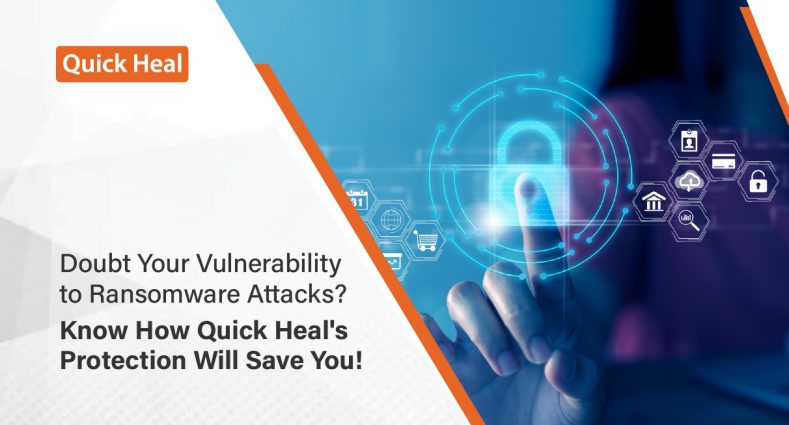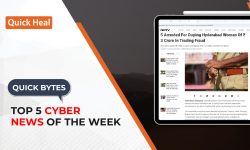Doubt Your Vulnerability to Ransomware Attacks? Know How Quick Heal’s Protection Will Save You!

So, picture this: you’re happily surfing the web, clicking through your emails, and suddenly… bam! Your computer freezes, and a scary message pops up demanding money. Welcome to the world of ransomware attacks! It’s like digital extortion.
Ransomware is malicious software that locks up your computer or encrypts your files, holding them hostage until you pay up. It’s like a virtual kidnapping of your data. Scary, right? These cyber-criminals are after your hard-earned cash, and they’re not playing nice. Globally, there were an estimated 236.1 million ransomware assaults in the first half of 2022.
How to tackle it? Stay tuned. We are going to look at how ransomware works, some real-life examples, and how you can stay digitally safe with Quick Heal Total Security.
The Sneaky Tactics Ransomware Uses to Invade Your System
Ransomware can sneak into your system through various avenues. It often disguises itself as harmless files or links in emails, tempting you to click. Sometimes it’s lurking in shady websites or bundled with software downloads. Once clicked or downloaded, it, encrypts your files and demands a ransom for decryption. Sneaky, right? It’s like a digital ninja, finding its way through cracks in your cyber defenses.
Ransomware attacks can ruin your security. According to IBM, fraudsters have sought ransom payments from victims ranging from $40 to $80 million. You need to be alert and we will help you with that. Let us first understand some of the big ransomware attacks that happened in a while –
-
WannaCry Ransomware attack
In 2017, a global cyber breach known as the WannaCry ransomware outbreak infected over 200,000 machines. The ransomware attack affected individuals across more than 150 countries. It was designed to exploit a flaw in unpatched Windows operating systems. WannaCry had a terrible effect, affecting hundreds of thousands of computer systems worldwide. The harmed data was encrypted and the scammers demanded $300 in Bitcoin from the victims to keep their data from being erased. Worldwide damage from WannaCry is estimated to have exceeded $4 billion. 19,000 appointments had to be canceled by the NHS in the UK, costing the health system over £92 million.
-
Darkside Ransomware attack
The biggest oil pipeline in the United States was attacked by a Darkside ransomware. This attack shut down 5,500 miles of vital pipeline and disrupted operations. Along the U.S. East Coast, the attack’s aftereffects included a shortage of fuel, rising gas prices, long lineups, and/or dry pumps. The corporation supplied 45% of the fuel supply for the East Coast, including gasoline, diesel, jet fuel, and home heating oil. The Colonial Pipeline stoppage resulted in ongoing shortages.
Have you ever been targeted by a ransomware attack?
Don’t worry! Quick Heal has developed a free ransomware decryption tool that can help decrypt files encrypted by the following types of ransomware. The tool is free and can be used without any hassle.
Ransomware Strikes Fear? Not Anymore! Quick Heal’s Got Your Back!
Here are five reasons why Quick Heal Total Security is your go-to shield against ransomware attacks:
- Real-time Protection: It’s like having a vigilant guard on duty 24/7! Quick Heal Total Security keeps an eagle eye on your system. We instantly detect and block any suspicious activity, including ransomware attempts.
- Advanced Behavioral Detection: This antivirus software isn’t just reactive; it’s proactive! It uses smart algorithms to spot ransomware based on its behavior, stopping it dead in its tracks before it can wreak havoc on your files.
- Ransomware Protection Shield: Quick Heal’s Total Security is like having an impenetrable force field around your important files! This feature targets ransomware, hence your precious data remains untouched by cyber threats.
- Automatic Backup: Even if ransomware somehow manages to sneak past the defenses, Quick Heal Total Security has your data backed up. You will never have to pay those pesky ransom demands!
- Security & Privacy Score: Provides insight on your risk situation, security status and personal data risk along with helpful tips for enhancing device security and privacy.
Final Take
Feeling vulnerable to ransomware attacks? #DigitalSafety with Quick Heal’s antivirus software for 365 days at just Rs. 1591 is your saving grace! With its robust security features and proactive defense mechanisms, Quick Heal Total Security offers a reliable shield against cyber threats. Don’t wait until it’s too late — safeguard your digital world with Quick Heal today and stay protected! Don’t forget to check out our free ransomware decryption tool too.



No Comments, Be The First!